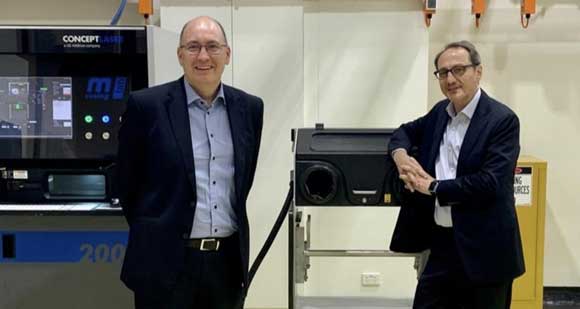GE Additive and University of Sydney to advance metal AM in Australia
January 4, 2021

GE Additive and the University of Sydney have entered into a strategic five-year agreement to advance Australia’s manufacturing capability. The agreement will establish metal Additive Manufacturing technology at the Sydney Manufacturing Hub, a space for training specialists and academics working in AM, and the incubation of small to medium manufacturing enterprises.
The hub is located at the University of Sydney’s Darlington campus and will enable advanced alloy design and applications to support a range of sectors including aerospace, defence, medicine and agriculture.
Following a Memorandum of Understanding (MoU) signed in 2018 and GE Additive’s agreement with the New South Wales government to develop Additive Manufacturing capabilities in Western Sydney, the parties will work together on developing the broader advanced manufacturing agenda within New South Wales and Australia.
Advanced manufacturing accounts for half of Australia’s manufacturing output and is one of the fastest-growing export sectors. The output of Australian manufacturing is estimated to reach AUD$131 billion by 2026, with advanced manufacturing potentially growing the domestic sector by approximately $30 billion over the next five years.
Sectors set to benefit from the reinvigoration of manufacturing using additive technologies are expected to include aerospace and space, the defence industry, robotics platforms, medical devices, construction, agricultural tech, oil & gas, and mining.
Sam Maresh, country leader, GE Australia, commented, “This is a breakthrough for Australia’s advanced manufacturing industry. Via the Sydney Manufacturing Hub, Australian manufacturers and small to medium enterprises (SMEs) will now have ready access to GE’s own production-grade additive technology.”
Chris Schuppe, General Manager – Engineering and Technology, GE Additive, stated, “GE Additive is committed to delivering specialist consultation, global-standard training, and industry workshops to enable key Additive Manufacturing research projects at the University of Sydney. We’d encourage Australia’s advanced manufacturing industry to leverage this opportunity to experience Additive Manufacturing in a fully supported environment.”
Professor Duncan Ivison, University of Sydney Deputy Vice-Chancellor (Research), added, “We are very excited to embark on a pioneering research program with GE Additive over the next five years. There is a huge amount of interest and excitement from both industry and the academic community, with whom we look forward to sharing our facilities and cutting-edge Additive Manufacturing technology.”
Prof Ivison continued, “The agreement is a significant catalyst in enhancing the advanced manufacturing capability of both the University and the region, which could bolster Australia’s competitive edge.”
Professor Simon Ringer, University of Sydney Director of Core Research Facilities and Faculty of Engineering explained how the recent coronavirus (COVID-19) crisis had exposed the country to vulnerabilities due to dependence on complex, ‘just-in-time’ supply chains – something that can be improved with Additive Manufacturing.
“Pre-COVID-19, a national focus on manufacturing resilience was generally regarded as a nice thought,” said Prof Ringer. “We have long believed this needs to be a critical national priority, and COVID-19 has raised the stakes. GE Additive and the University of Sydney, working alongside government and Australian SMEs, will be at the forefront of delivering this capability.”
“A manufacturing renaissance is coming and for Australia to lead in this space, there must be an investment in skills,” he continued. “Through the use of a smart facility, the University of Sydney is best placed to develop them and bring forward a new era of innovation. Our commitment to this area is backed by a recent report released by the NSW Office of Chief Scientist and Engineer, outlining the significant economic return our world-leading research infrastructure provides to the state and nation.”
















